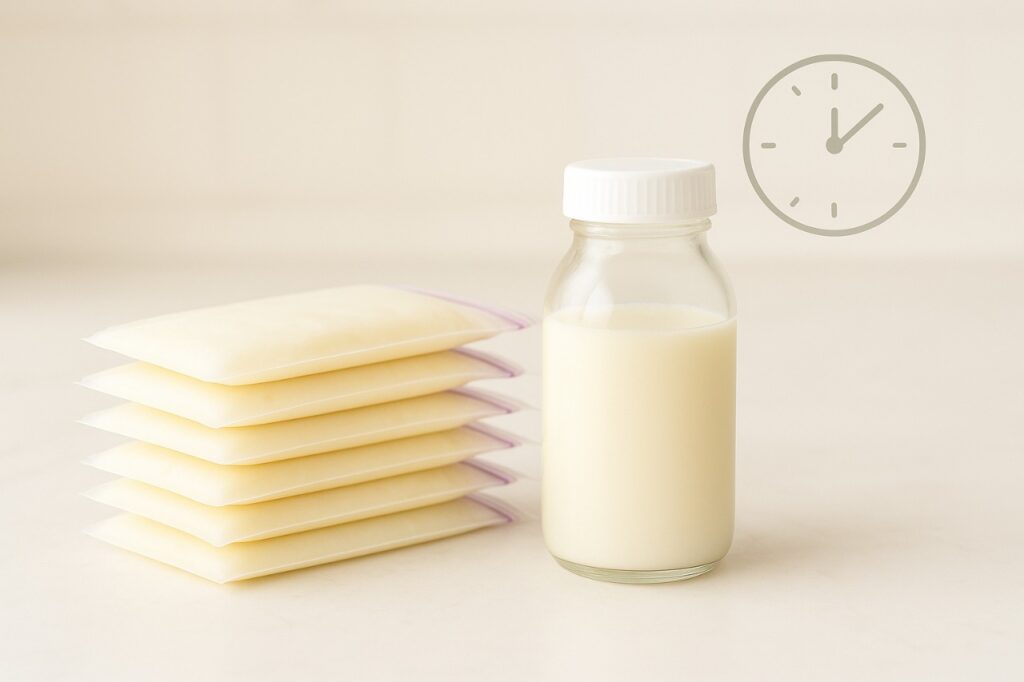Why Proper Breast Milk Storage Matters for U.S. Moms
For new moms across the U.S., learning how to store breast milk safely is one of the most important steps in ensuring a healthy feeding routine. Breast milk isn’t just food — it’s full of living nutrients, enzymes, and antibodies that protect your baby from illness. But when stored incorrectly, it can lose vital nutrients or even become unsafe to use. Proper storage techniques keep milk fresh, nutritious, and ready whenever your baby needs it.
👉 If you want to know how long milk stays fresh, check out How Long Does Breast Milk Last? (Full U.S. Safety Guide)
Understanding the Basics of Safe Storage
The foundation of breast milk storage is simple: clean containers, proper labeling, and temperature control. Always start by washing your hands thoroughly and using sterilized, food-grade containers or storage bags. Label each bottle or bag with the date and time of expression so you can use the oldest milk first.
It’s also important to store milk in small portions — about 2 to 4 ounces per container — to avoid waste when thawing.
Where and How to Store Breast Milk
Breast milk can be safely kept at room temperature, in the fridge, or frozen — but each option has its own time limit.
If you plan to use the milk within a few hours, you can leave it at room temperature (up to 77°F / 25°C) for about 4 hours, as long as the room is cool and away from direct sunlight.
If you’re traveling or pumping at work, use an insulated cooler with ice packs, which keeps milk safe for about 24 hours.
For everyday storage, the refrigerator (≤ 40°F / 4°C) is ideal — breast milk stays fresh there for up to 4 days, especially if placed at the back rather than the door.
For longer storage, you can freeze it. In a freezer attached to the fridge, milk lasts up to 2 weeks, while in a deep freezer (0°F / -18°C or below), it can stay safe for 6 to 12 months.
👉 For a practical organization method, read our detailed guide on How to Organize Breast Milk in Freezer (Flat-Freezing & FIFO Guide)
Choosing the Right Storage Containers
Always pick containers that are specifically made for breast milk. Pre-sterilized breast milk storage bags are space-saving and perfect for freezing. Glass bottles with airtight lids are reusable and chemical-free, while BPA-free plastic bottles are great for travel and daycare use.
Before freezing, leave about an inch of empty space at the top of the container — breast milk expands as it freezes, and that small gap prevents leakage or breakage.
Labeling and Organizing Milk Properly

Always write the date and time you pumped the milk. When storing in bulk, use the FIFO (First In, First Out) method — always use the oldest milk first and move newer milk to the back.
For easy tracking, many moms use color-coded labels or freezer baskets divided by week. This method ensures that no milk is forgotten or wasted.
How to Freeze and Thaw Milk Safely
When freezing milk, lay the storage bags flat on a clean tray. Once frozen, stand them upright in a container or basket — it saves space and thaws evenly.
To thaw, transfer the frozen milk to the refrigerator overnight or warm it by placing the sealed bag in a bowl of warm (not hot) water. Never microwave breast milk, as that destroys nutrients and creates hot spots.
After thawing, gently swirl the milk to mix the cream layer — don’t shake it hard, as it can break down vital proteins.
Recognizing Spoiled or Unsafe Milk
Fresh breast milk has a light, sweet scent. If it smells sour, rancid, or metallic, it’s likely spoiled. The color can vary slightly, but curdled or clumpy milk should always be discarded.
If you’re unsure, do a quick smell test — safe milk will always have a mild, clean aroma.
Expert Safety Guidelines from U.S. Health Authorities
The Centers for Disease Control and Prevention (CDC) recommends storing milk in clean, food-grade containers and never reusing single-use bags. It also emphasizes keeping milk at stable temperatures and labeling every batch clearly.
The American Academy of Pediatrics (AAP) suggests avoiding microwaving or rapid heating and encourages gentle thawing to preserve antibodies and enzymes. Following these official guidelines keeps both safety and nutrition intact.
FAQ: Common Questions About Breast Milk Storage
Q1: Can I mix freshly pumped milk with stored milk?
Only if both are at the same temperature. Cool the fresh milk in the fridge first before adding it to the stored batch.
Q2: Can I reuse a bottle after feeding if there’s milk left?
It’s best to use within 2 hours or discard it. Bacteria from the baby’s mouth can quickly multiply in leftover milk.
Q3: Can I refreeze milk once thawed?
No. Once thawed, breast milk must be used within 24 hours and should never be refrozen.
Q4: Are silicone milk storage bags safe?
Yes, they’re eco-friendly and reusable, as long as they’re sterilized properly.
Q5: How do I know if my milk has gone bad?
If the smell is sour, the consistency uneven, or your baby refuses it, it’s safer to throw it away.
Conclusion: Smart Storage Means Safer Feeding
Breast milk storage is about care, cleanliness, and consistency. When stored correctly, it keeps your baby’s milk fresh, safe, and full of nutrients.
With labeled containers, proper freezing habits, and gentle thawing, you can build a reliable milk stash that saves time and supports your baby’s health.
Follow the same steps used by pediatricians and lactation experts — because when it comes to your baby’s nutrition, safe storage is the first step toward peace of mind.

